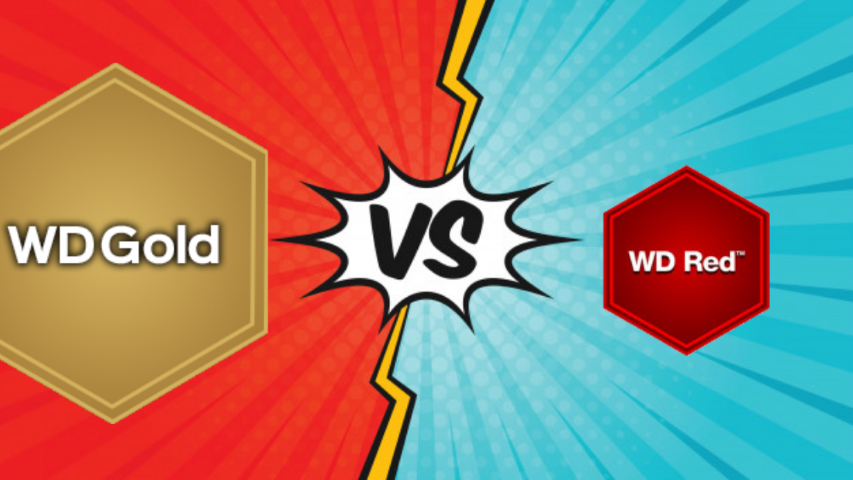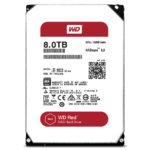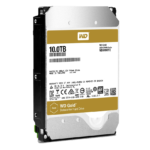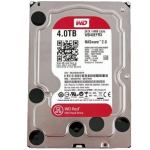Should you use WD Gold or WD Red Pro Drives in your NAS?
When choosing the right NAS server, one of the most important decisions you will make is the kind of hard drive media that you want to install. Different NAS server devices from Synology to QNAP will have different CPU and Memory options, however, the hard disks that you choose to install inside will have a massive impact on both the performance speeds of your NAS, as well as your long-term stability and support. More and more users are turning towards enterprise-class and more ruggedly designed NAS drives in order to ensure their data is both fast and stable and of all the companies out there supplying drives, Western Digital (WD) are one of the best in providing high-quality drives. Despite enterprise drives such as WD Gold and WD Red Pro being designed with much larger RAID arrays in mind, even 2-Bay NAS buyers are starting to install these high-end drives in their devices, thanks to a myriad of hardware and support advantages.
https://www.youtube.com/watch?v=GguADcFLEeY
Why Choose WD Gold and WD Red Pro over regular Hard Drives in your NAS?
Back when hard drives were first being produced, petty much all hard disks were identical in design. The technology was not hugely developed and the priority over all things was capacity. However, later on, this gave way to a more balanced opinion of leveraging capacity versus stability and that was when we started seeing more tailored drives being produced such as the WD Green that was designed for low energy situations or the WD Black that was designed for much more rugged, heavy use. It stands to reason that when you have data being created in almost all industries and environments around the world, that different hard drives for different needs would have to be produced, i.e. there are many, many kinds of spoons – but you wouldn’t use a ladle to stir your tea!
This rule is made especially important with NAS servers. NAS devices can be in operation for weeks and/or months at a time, have very sporadic read and write actions and generally involve RAID (redundant array of independent disks) which means a higher degree of stability whilst multiple disks are accessed at the same time is essential. Regular NAS hard drives such as WD Red and Seagate Ironwolf as excellent for this, but even they have a few shortfalls if you are a business user, intend to access your data much more regularly or want a much more comprehensive solution. Below are the difference between NAS hard drives and WD Red Pro and WD Gold.
Advantages of WD Red Pro and WD Gold
- Longer Warranty
- Higher Read and Write speeds (around 200MB/s, whilst regular WD Red is around 90-100MB/s)
- Better for larger RAID arrays of 8 or more drives
Advantages of WD Red
- Quieter whilst in use
- Lower Price per Terabyte
- Smaller Capacities are available
WD Red Pro versus WD Gold – Which is Best?
As the chart above shows, Pro class drives such as the WD Red Pro and the WD Gold have most of their advantages in stability, long-term coverage and speed. This isn’t a huge surprise and with capacities getting bigger (WD Gold and WD Red Pro in 12TB) the option of a small yet powerful 2-Bay NAS and two PRO class drives is very appealing (for small business), as the price will only be around £10 extra per terabyte of hard drive. But should you buy WD Gold (designed for data centers) or WD Red Pro (designed for NAS)
The simple truth is that these two drives are just too similar for their construction and quality to separate them. What little difference (the MTBF seems better on the WD Gold, the max operational time is the tiniest bit higher on the WD Red Pro as they use less power) can be overlooked as the test environment and intended usage situation of both is different. At a pinch I would recommend the WD Gold, as they are identical in price and the support and warranty service overall will be quicker for an RMA on a WD Gold drive, as these are considered enterprise – sadly even WD would have to admit they a business user will always prioritize over a home user. But apart from that, your choice can always come down to traditional factors such as price and capacity. It is certainly worth highlighting that the newest and biggest capacities always arrive in the WD Gold range first.
🔒 Join Inner Circle
Get an alert every time something gets added to this specific article!
This description contains links to Amazon. These links will take you to some of the products mentioned in today's content. As an Amazon Associate, I earn from qualifying purchases. Visit the NASCompares Deal Finder to find the best place to buy this device in your region, based on Service, Support and Reputation - Just Search for your NAS Drive in the Box Below
Need Advice on Data Storage from an Expert?
Finally, for free advice about your setup, just leave a message in the comments below here at NASCompares.com and we will get back to you. Need Help?
Where possible (and where appropriate) please provide as much information about your requirements, as then I can arrange the best answer and solution to your needs. Do not worry about your e-mail address being required, it will NOT be used in a mailing list and will NOT be used in any way other than to respond to your enquiry.
Need Help?
Where possible (and where appropriate) please provide as much information about your requirements, as then I can arrange the best answer and solution to your needs. Do not worry about your e-mail address being required, it will NOT be used in a mailing list and will NOT be used in any way other than to respond to your enquiry.

|
 |







Honestly, buy the cheapest drives for a NVR, that is my opinion, and if they happen to be enterprise drives, great. Mission critical data does not exist on a NVR.
REPLY ON YOUTUBE
yo great info! Quick suggestion, fix your audio syncing. The audio is off from your lips when talking. If you want help doing that I can help ya quick.
REPLY ON YOUTUBE
Thanks!
REPLY ON YOUTUBE
Good lord it takes this guy forever to get to the point.
REPLY ON YOUTUBE
too long
REPLY ON YOUTUBE
Slow down the cadence.
Learn from professional presenters.
Motor Mouth is not desirable as it forces
the listener to be hyper-focused on what you are saying.
Go TOILETTE first before starting your presentation.
And remember it is not a RACE
REPLY ON YOUTUBE
I am using fork
REPLY ON YOUTUBE
ice cream spoon in the tea would go quite nice actually
REPLY ON YOUTUBE
Black: High performance for gaming, editing, and intensive tasks.
Blue: Balanced performance for general everyday use.
Green: Eco-friendly, low-power for storage and backup.
Red: Optimized for NAS systems and RAID setups.
Purple: Tailored for surveillance, supports continuous video recording.
Gold: Enterprise-grade, reliable for servers and data centers.
REPLY ON YOUTUBE
I liked and subscribed thanks ????????
REPLY ON YOUTUBE
Just checked prices and the difference between NAS and “normal” drives is too little to matter.
REPLY ON YOUTUBE
Can I use a NAS Hardrive as a storage on my PC Build ?
REPLY ON YOUTUBE
I been using a Red 6TB in my gaming pc for years perfectly fine. I don’t make big income and wanted something that will last.
REPLY ON YOUTUBE
I used Raptors back in the ’90’s.
REPLY ON YOUTUBE
Can I Install Used Seagate IronWolf Pro, 6 TB (its for 195aed in facebook marketplace) , to a Desktop? i have an ASUS B360M-K motherboard trying to do a PC build
REPLY ON YOUTUBE
Colors*
REPLY ON YOUTUBE
I have one clarification question for my next build and/or a possible take away. Based on your video… it is safe to assume i should not put a regular 5400rpm hard 3.5 drive into a NAS but in theory can do the opposite. Seems I CAN put a 3.5 mm 7200 10gig NAS drive in a computer for deep onboard file storage? Over the next year, I plan to stagger build a PC then NAS, and was hoping to the use larger capacity 3.5 drives in my PC first and then migrate those cold storage drives to the upcoming NAS down the road (buy once/cry once) will I run into any issues with this plan? will I have to offload data before building the NAS file system repositories on those 3.5s or can it adapt? Am I missing anything else unforeseeable? (I haz small lizard brainz)
REPLY ON YOUTUBE
I have one clarification question for my next build and/or a possible take away. Based on your video… it is safe to assume i should not put a regular 5400rpm hard 3.5 drive into a NAS but in theory can do the opposite. Seems I CAN put a 3.5 mm 7200 10gig NAS drive in a computer for deep onboard file storage? Over the next year, I plan to stagger build a PC then NAS, and was hoping to the use larger capacity 3.5 drives in my PC first and then migrate those cold storage drives to the upcoming NAS down the road (buy once/cry once) will I run into any issues with this plan? will I have to offload data before building the NAS file system repositories on those 3.5s or can it adapt? Am I missing anything else unforeseeable? (I haz small lizard brainz)
REPLY ON YOUTUBE
So which one is good for archival type of storage. For long period of times?
Is WD black good?
REPLY ON YOUTUBE
On of the worst hard disk i had was wd…i lost my huge data..so i reqest to keep away from this..
REPLY ON YOUTUBE
So… what’s the deal with the (phony ? ????) book cabinet? At first I noticed some books that look very similar, but when you observe this more closely, obviously with a WD purple built for surveillance, you will notice that the book pattern, so the books in sequence repeat themselves on every shelf. Unless ofcourse, something is wrong with the Raid stripes on my wd purple nas! ????
REPLY ON YOUTUBE
I have my NAS set up to spin down HDDs after 30 min of no access and the only drives to have failed in the time have all been Seagate with Hichai and WD drives still going 10 years later, the replacements were Toshibas so we will see if they can keep up with their 20gb ancestor from 20+ years ago.
REPLY ON YOUTUBE
The different SKU might not entirely be a scam, but the difference in pricing most certainly is. What makes the WD Purple 40% more expensive to manufactured compared to their Ultrastar Datacenter Drives in the same capacity?!?
REPLY ON YOUTUBE
I know this is a really old video but I want to put in my $0.02 so I might help some people…
Having worked in many data centers for a hand full of storage companies I can say a large portion of the hard drives they use are bog standard “consumer* 7200 rpm SATA HDDs, not some special type “designed” for NAS, RAID, or data center use. There is essentially no difference between drives labeled for “NAS”, “Desktop”, “Data Center”, etc.
It doesn’t matter if you use a drive in RAID or on its own either, the drives have no idea they are in RAID so the idea that one drive can better deal with another drive in the array failing is complete nonsense. This video just reiterates what hard drive makers want you to believe so you’ll spend more on hard drives.
For anyone trying to figure out what line of drive you should get for your NAS just get the “desktop drive” in the capacity you want.
REPLY ON YOUTUBE
Why is there no mention of Error Recovery Control (ERC) / Time Limited Error Recovery (TLER) as another significant difference between standard desktop use drives and NAS drives? You want ERC in a drive intended for raid so it doesnt hang when an intermittent problem occurs and break your raid by dropping the drive while it re attempts to access the block before it gives up and marks it as a bad block. And not Ideal in a single drive use as you want the drive to actually try to access the data because you have no redundancy. In a single drive use that data isn’t stored anywhere else so its not beneficial to just drop it at the first sign of a read delay.
REPLY ON YOUTUBE
Buzilsa soz bo’ladimi
REPLY ON YOUTUBE
Hello, can i use WD Red 4tb just as file storage with Orico HDD Enclosure ?
REPLY ON YOUTUBE
Just found this video https://www.youtube.com/watch?v=9AMFz3riawI – they teardowned the Seagate Baracuda Gaming Dock.
its said on the Seagate´s official product page that:
“””…Massive Storage Space – Archive projects, store older games and media files, plus enjoy plenty of space for tomorrow’s hot titles with 4 TB of expansive hard drive capacity….”””
And now take a gueas what HDD is inside??? – What Seagate put there as a HDD for a large amount of data???
????????????Iron wolf pro NAS with a slot for SSD. ????????????
REPLY ON YOUTUBE
Just found this video https://www.youtube.com/watch?v=9AMFz3riawI – they teardowned the Seagate Baracuda Gaming Dock.
its said on the Seagate´s official product page that:
“””…Massive Storage Space – Archive projects, store older games and media files, plus enjoy plenty of space for tomorrow’s hot titles with 4 TB of expansive hard drive capacity….”””
And now take a gueas what HDD is inside??? – What Seagate put there as a HDD for a large amount of data???
????????????Iron wolf pro NAS with a slot for SSD. ????????????
REPLY ON YOUTUBE
❓ Can I use Irowolf pro in my desktop just for data? I mean I have system on ssd and I need a disk for thousands of photos/videos (stored on desktop not on NAS – to be able to work with them)? I dont want baracuda (8TB) because they are just 5400 and I want 7200 for sure. Baracuda pro sells no shop any more 🙁 Even firecuda are not sold. So which disk for data on my desktop❓
REPLY ON YOUTUBE
A NAS HD will ALWAYS be good for desktop purposes. If not overkill then still always better than a NON Nas HD.
Yes we all know SSD is THE fast boot option but most users need storage space as well.
Lesser programmes we are happy to run at a slower pace also fit the bill for a second, slower storage option for various budgets, like a HD as a D:/ or whatever the owner chooses.
Gone are the days D:/ was reserved for a CD/DVD/Even Blue Ray player.
The point is, do you do enough on your PC that you need a HD as robust as a NAS HD?. If you are like me and live on your PC the answer is YES!
First I will be getting a 10TB Nas drive to compress and hopefully save all the data on my 2 x 10TB hd’s that are both external and not full, so with Winrar/zip I may get there lol. I feel the need to back up as they have both had issues even with the less demanding USB 3.0 connection. Too many USB connections also slows down boot up BAD!
Already backed up basic needs to a separate HD but…….
The 2 x 10Tb externals overheat in their external cases because I am using them as I would a not very busy NAS.
Constantly losing connection while processing several hundred video files in sequence these days, so waking to a morning PC that did SFA overnight, whereas a NAS system would have sorted it by NEVER being disconnected due to USB issues 🙁
Time to stretch the budget!
Thank for the affirmation that NAS drives ARE ACTUALLY BETTER! Cheers 🙂
REPLY ON YOUTUBE
Platter density is a less discussed spec that interests me. Higher density increases reliability from less parts and less vibration.
REPLY ON YOUTUBE
For the people who want to skip the ridiculous ramble and just want the answer 2:38 you’re welcome.
REPLY ON YOUTUBE
Wanting to buy a NAS for the first time, and this channel is pure gold 😀
REPLY ON YOUTUBE
The “R” in RAID is “Redundant” not “Random”. Good informative video though.
REPLY ON YOUTUBE
I installed 4TB WD NAS HDD 8 years ago in my regular desktop and it still running with out any problem.
REPLY ON YOUTUBE
can i put NAS HDD on my laptop? (aka putting it inside the motherboard’s slot)
REPLY ON YOUTUBE
Could i use a NAS drive for backup(for my Pc files etc)? Let’s say i can get them cheap. Is it even compatible with win 10?
REPLY ON YOUTUBE
Hi thanks for the great content. I am currently thinking of moving from local hdds to nas. What if I use a NAS HDD for desktop first to copy some data from local storage then put the HDD to a NAS system? Does it work?
REPLY ON YOUTUBE
Can I put a NAS hdd to my gamer desktop and run games from it well?
REPLY ON YOUTUBE
that is a very tacky wallpaper.
either have a shelf full of books or don’t.
why pretend to?
REPLY ON YOUTUBE
i have in my nas disk from running 2013 – 2021 on 6 desktop hdd. toshiba p300 and wd green. no problems at all 😉 so bullshit.
REPLY ON YOUTUBE
This guy is clueless
REPLY ON YOUTUBE
The answer to the question starts at 2:40 but doesn’t really help with the problem.
REPLY ON YOUTUBE
I bought 2 x nas hhd for my pc so that I can put all my photos and videos onto them.
REPLY ON YOUTUBE
What would you recommend for a PC running RAID 1 but used as a Blue Iris server? I know solid state is the best but not affordable in 2TB. I was looking at a Seagate BarraCuda 7200 256MB ST2000DM008. Only running 5 cameras but the drives I’m running now are 5400 and cuts off much of the video.
REPLY ON YOUTUBE
How about some braces?
REPLY ON YOUTUBE
So I should buy a NAS to store all my videos and pictures? I want to use it as a data-grave.
REPLY ON YOUTUBE
I guess that there won’t be a problem running a NAS Drive in my regular Desktop PC(for dumping my old Data)?
It’s not failing because of “Under-Utilisation” or something?
REPLY ON YOUTUBE
This guy talks too much and is not correct. I Have 4 nas setups that I’ve had running for 6 + years 24/7. The WD Reds are marked NAS and they are only 5400 RPM. They are SLOW but run cooler and are cheaper to make.
Most nas drives are 5400-5900 rpm they run coolers but are not ENTERPRISE server drives.
I have a 5TB raid 1 Hitachi 7200 RPM drives that way out perform official nas drives. They have been up 6+ years 24/7. My first drives to go bad were the WD Reds not the 7200 RPM drives.
I think its mostly marketing you can put any HD pair in a NAS and they will run fine. I have not found WD Reds to last any longer than any other HD and less than say Dell Enterprise SAS drives.
The vibration stuff is hogwash too, ive not found a issue with non nas drives. I have put NAS drives in a Dell server to test and they were dog slow vs the 7200 RPM enterprise drives and way slower than the 10,000 and 15,000 RPM sas drives. Again My SAS drives are all raid (LSI controller) and are on 24/7 for years. My home PC is on 24/7 I never turn it off and my 4TB 3TB 7200 rpm and SSD are all fine. 3 years 24/7. I leave all my PCs on never turn them off. Its harder on the components to turn ON/OFF/ON/OFF all those heating and cooling cycles does more harm than leaving it on.
I think a good compromise is the Iron Wolf 5900 NAS drives they perform around 180MB/sec which is decent.
REPLY ON YOUTUBE
I have a 8TB WD Gold for art designs, photography and games, too much?
REPLY ON YOUTUBE
Two reasons I choose WD Gold over WD Red Pro. (1) WD Gold runs about 10 deg F cooler – may lead to longer drive life. This is from having them in the same enclosure for months before I fully switched over to Golds. (2) In a RAID5 array, which is probably the most common config for home NASs, the time when the array is most stressed is when the array is rebuilding, either due to adding/swapping a drive for a failure or upgrade. WD Golds are designed to be continuously hammered in a datacenter environment so the stress from rebuilding is essentially the standard design parameter for this drive.
(A Labo)
Plz tell me how to buy a same model hard disk… Just all wd blue internal hard drive are same or not…
How to buy a same model hard disk for my laptop…just wauching a Serial number or model number.
REPLY ON YOUTUBE